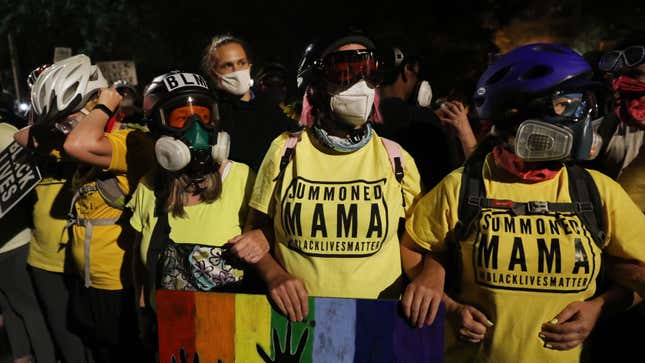'Our Pain is Not An Asset': Inside the Breakdown of the Wall of Moms
Latest

Last Wednesday, Portland’s leading anti-police violence and Black-led organization Don’t Shoot Portland posted a message on their Instagram account, documenting a break with the Wall of Moms, a loose grouping of largely white women that had formed in response to the Trump administration’s sending of federal law enforcement agents to the city and the violence directed against Black Lives Matter protesters. The Wall of Moms had begun as an effort to use their bodies as a physical barrier between protesters and federal agents, using their status as so-called “Target moms” to both protect protesters and proclaim that white mothers believed that Black lives matter. After the first night, they kept going and growing, transforming from a one-off Facebook event into something that could be called an organization. In the two weeks since they first linked arms and sang lullabies at protests, the moms in yellow t-shirts and gas masks had gained so much attention, most of it glowing, that they had inspired similar groups to organize in other cities.
But as Don’t Shoot Portland put it in their Instagram post, they no longer trusted the leadership of Wall of Moms, in particular its founder Bev Barnum.
“The lies are finally clear and we are sad but ultimately not surprised that anti-Blackness showed it’s [sic] ugly face with Wall of Moms,” the group wrote in the caption, and they urged their followers to no longer support Wall of Moms under Barnum’s leadership. “We need everyone to show up against racism, but it’s even more crucial to prioritize transparency and accountability,” Don’t Shoot Portland wrote, adding, “WE ARE NOT AGAINST MOMS! EVERYONE HAS A PLACE IN ORGANIZING.”
Soon after Wall of Moms began organizing, Don’t Shoot Portland had agreed to partner with the group, a partnership that Don’t Shoot’s founder Teressa Raiford told Jezebel was meant to help guide Wall of Moms’ organizing efforts and channel them towards efforts led by Black organizations. “The need is always for mutual aid, the need is always to show up,” Raiford said, and she hoped that the members of the group would take part in actions beyond just the nightly protests at the courthouse. In an Instagram post on July 24, Wall of Moms had lauded their work with Don’t Shoot, describing it as a “deepening of a powerful collaboration that will more firmly root us in our collective goals of ending racism, healing historic and ongoing wrongs, and doing the hard but much needed work of healing our society and world from the legacies of colonialism, racism, and white supremacy.” Wall of Moms also announced that they had realized it was “problematic” for the group’s leaders to be composed of primarily white women, and that their leadership would continue to include Barnum (who is Mexican American, though she has described herself as “white appearing”), as well as a group of Black women, including Raiford. It was, the group wrote, an update they were “eager” to share.
Raiford told Jezebel she was bothered by that post, which had more than a whiff of the self-congratulatory about it. “I didn’t like the fact that the language [said] that white women were giving something to Black women that already had shit,” Raiford said. “Nobody cared,” she said, about who was running the group; the concerns that had been raised during the numerous Zoom calls she had participated in centered around moderation of comments on the group’s Facebook page, which at times took on a tone of white saviorism when questions were raised about whether the moms were shifting the focus from Black Lives Matter to a group of largely white women.
“Why would you make it about yourself when we’re already out here doing the work? Why try to co-opt that?”
But more troubling in practice, according to Raiford, Barnum disregarded the needs and input of Black women. Raiford pointed to incidents that she said made her and others distrust Barnum’s leadership. Don’t Shoot Portland had heard from Black women that, as they wrote, “they were not protected by WOM leadership” at protests at the Portland federal courthouse. One such incident occurred last Tuesday evening, when Barnum had gotten into an argument with Demetria Hester, a long-time activist who had signed on as the group’s on-the-ground protest coordinator. According to Raiford as well as Rashelle Chase, a Wall of Moms member who had signed up to help with administration of the group’s Facebook page, Barnum then abruptly decided to pull the group out of the protest, leaving Hester alone at the courthouse with no security, a move that was particularly alarming because it was widely known that Hester had in the past been attacked by a man screaming racist slurs, who was eventually convicted of killing two people in a Portland light-rail car. According to Don’t Shoot, similar incidents had happened before, which had “put many on the ground in direct danger.” Chase also told Jezebel that Barnum’s heavy-handedness had already led both the volunteer head of the group’s medic team to quit in protest, as well as the group’s volunteer marketing head.
(When reached, Barnum referred Jezebel to a member of Wall of Moms’s marketing team, who didn’t respond to requests for comment by the time of publication. On Twitter, Barnum wrote last Wednesday, “The court of public opinion is strong. It’s unfortunate Teressa refuses to take any responsibility for what has transpired. It’s okay, though. @WallOfMoms is a protected nonprofit now and those that seek to harm it can be punished by law.”)
-

-

-

-

-

-

-

-

-

-

-

-

-

-

-

-

-

-

-

-

-

-

-

-

-

-

-

-

-

-

-

-

-

-

-

-

-

-

-

-








































